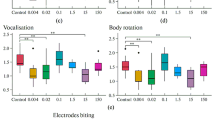Abstract
Thyrotropin-releasing hormone (TRH) and its synthetic analog digipramine (DP) shortened the latency of the tail-flick response in mice when injected intraperitoneally in a dose of 5 mg/kg and to potentiate significantly the analgesic action of morphine. Possible mechanisms of these two effects and prospects for their medical use are discussed.
Similar content being viewed by others
References
A. M. Balashov and M. R. Shurin,Byull. Eksp. Biol. Med.,102, No 8, 174 (1986).
G. P. Vlasov, E. K. Georgianova, N.Yu. Kozhevnikova,et al., in:Neuropeptides: Their Role in Physiological and Pathological States (Abstracts of papers) [in Russian], Tomsk (1985).
N. A. Osipova,Assessing the Effect of Narcotics, Analgesics, and Psychotropic Agents in Clinical Anesthesiology [in Russian], Leningrad (1988).
P. Ya. Romanovskis, Sh. V. Svirskis, and G. I. Chipens, Author's Certificate No 892870,Byulleten' Izobretenii, No 47, 296 (1981).
H. N. Bhargava,Life Sci.,29, 1015 (1981).
G. Boschi and R. Rips,IRCS Med. Sci.,9, 200 (1981).
G. Boschi, M. Desiles, V. Reny,et al., Brit. J. Pharmacol.,79, 85 (1983).
R. W. Clarke, T. W. Ford, S. M. Harris, and J. S. Tailor,Neuropharmacology,27, No 12, 1279 (1988).
F. E. D'Amour and D. L. Smith,J. Pharmacol. Exp. Ther.,72, 74 (1941).
E. C. Griffiths,Psychoneuroendocrinology,10, 225 (1985).
J. W. Holaday, R. J. D'Amato, B. A. Ruvio, and A. Faen, in:Thyrotropin-Releasing Hormone, edited by E. Costa and M. Trabucchi, New York (1982), p. 353.
J. W. Holaday, G.-F. Tseng, H. H. Loh, and C. H. Li,Life Sci.,22, 1537–1544 (1978).
A. Horita, M. A. Carno, and R. M. Chestnut,Psychopharmacology,49, 57–62 (1976).
C. Oliver, R. L. Eskay, N. Ben-Jonathan, and J. C. Porter,Endocrinology,96, 540 (1974).
A. Tjolsen, A. Lund, P. K. Eide,et al., Pharmacol. Biochem. Behav.,32, No 3, 601 (1989).
Author information
Authors and Affiliations
Additional information
Translated fromByulleten' Eksperimental'noi Biologii i Meditsiny, Vol. 118, No 8, pp. 117–119, August, 1994
Rights and permissions
About this article
Cite this article
Guseva, A.A., Gurskaya, I.E., Romanovskis, P.Y. et al. Potentiating effect of thyrotropin-releasing hormone and of its synthetic analog digipramine on morphine-induced analgesia. Bull Exp Biol Med 118, 803–805 (1994). https://doi.org/10.1007/BF02444432
Received:
Issue Date:
DOI: https://doi.org/10.1007/BF02444432



